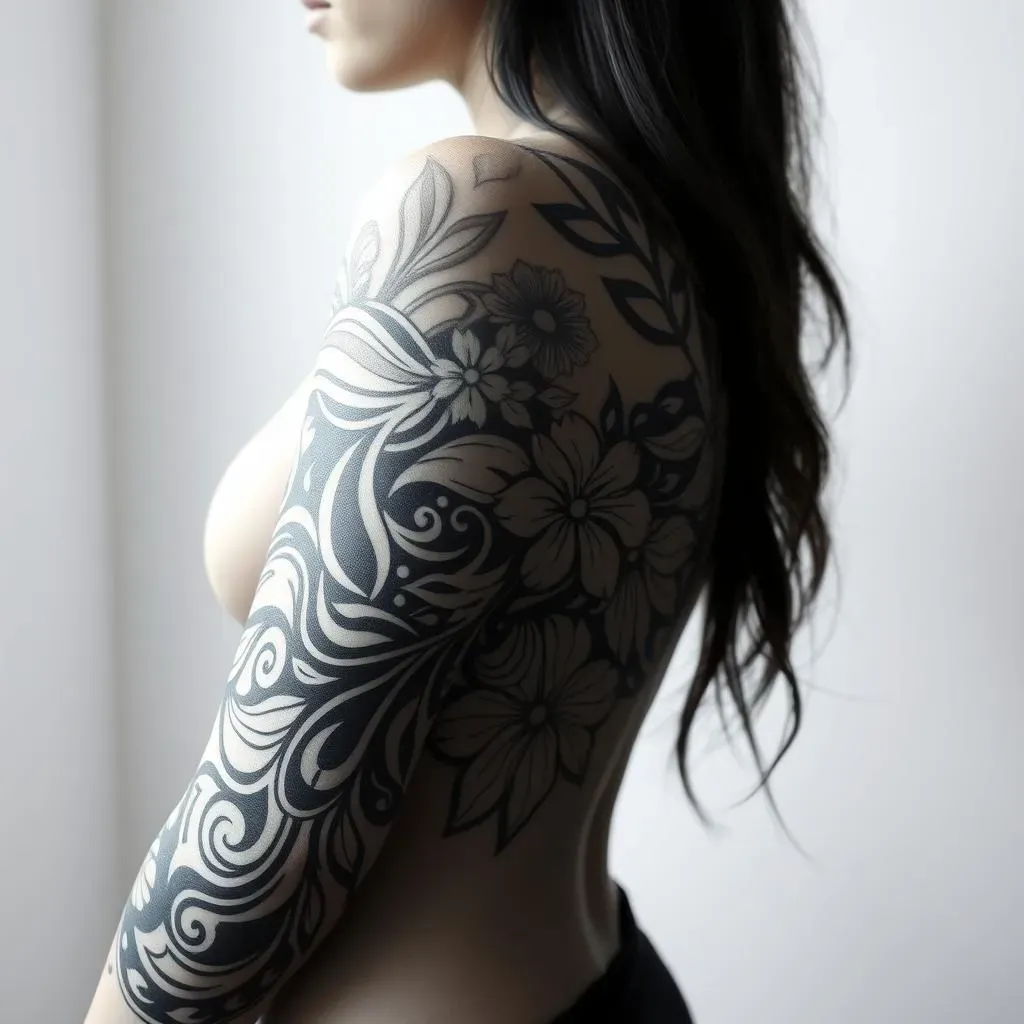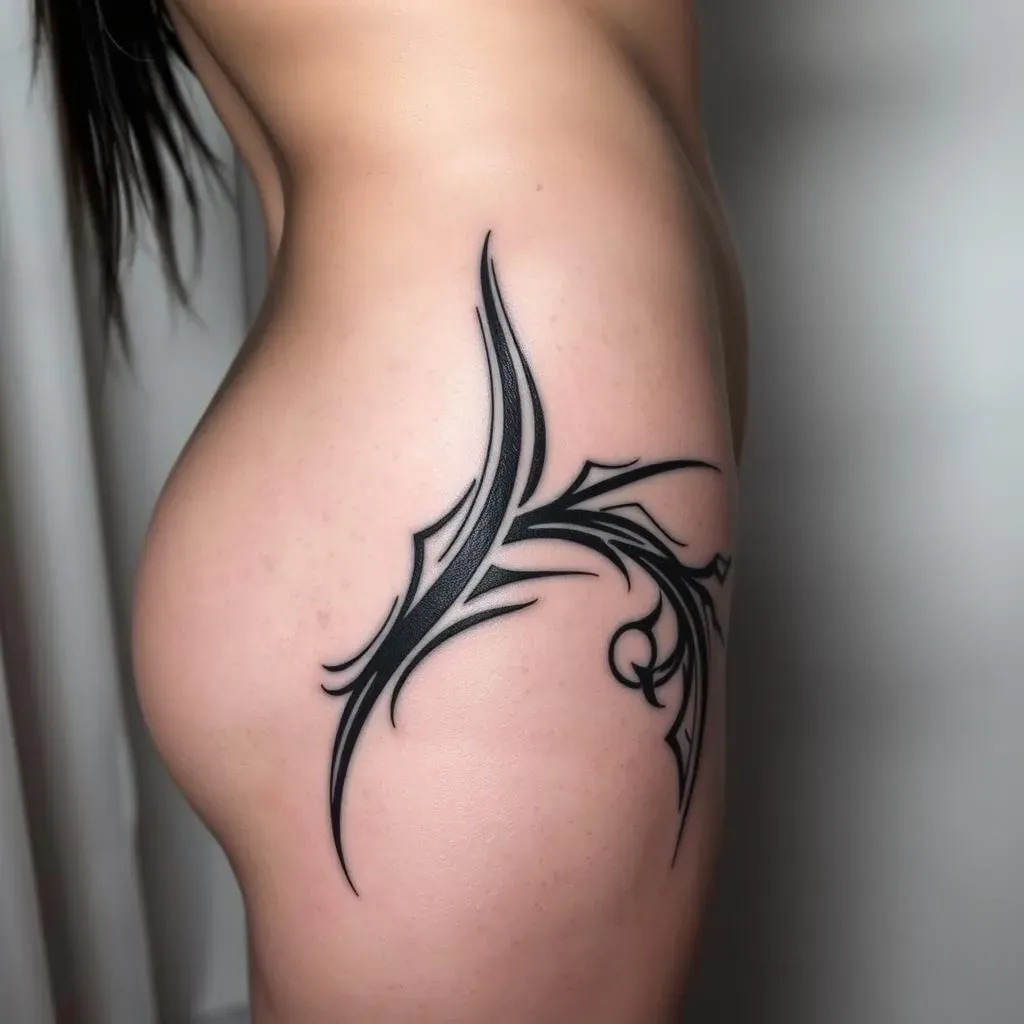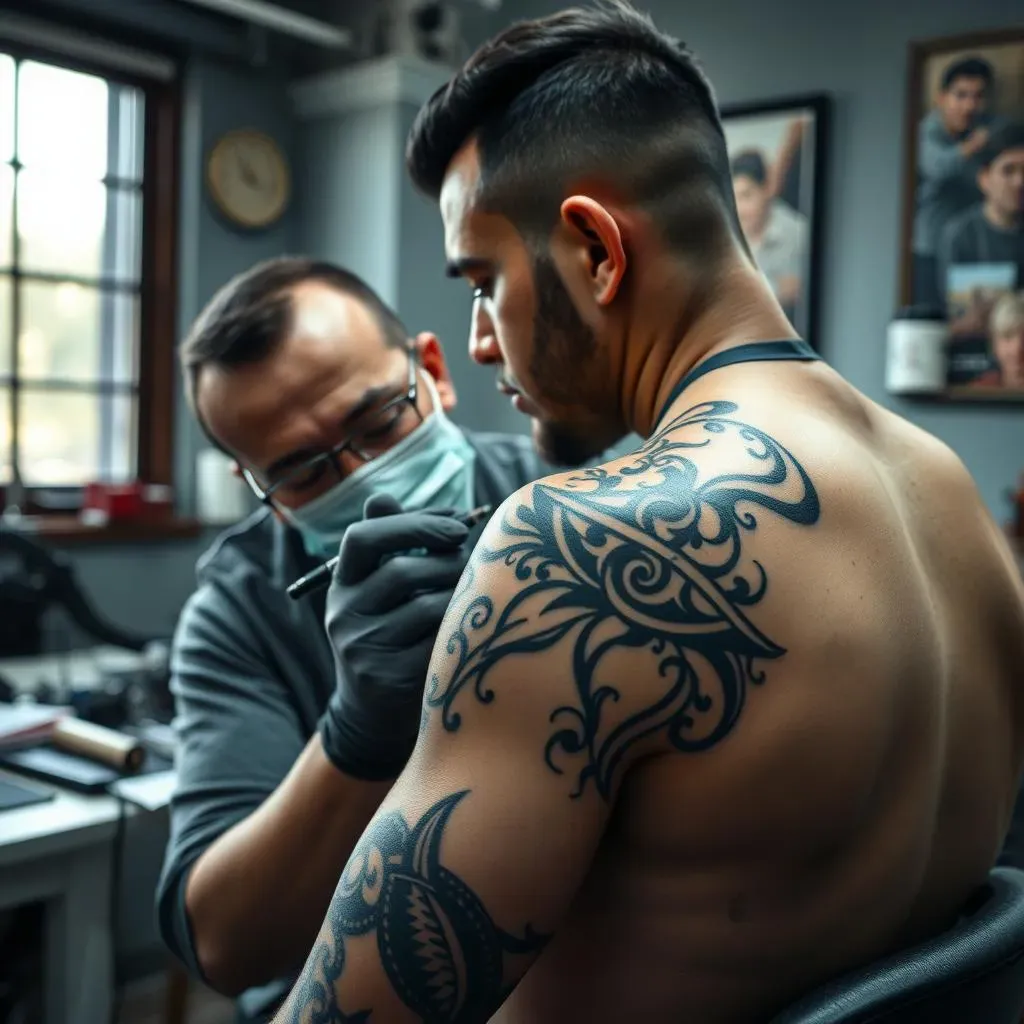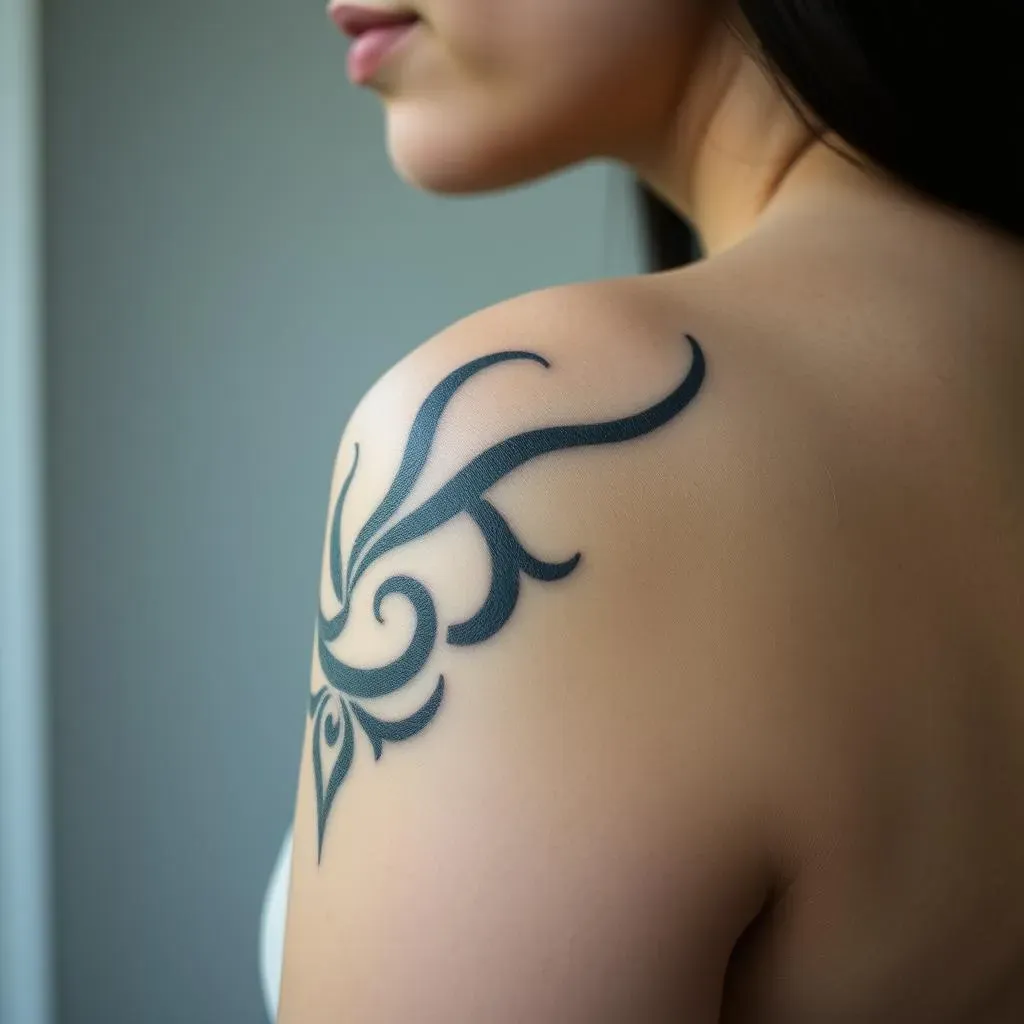Table of Contents
Ready to explore the captivating world of body art? This article is your guide to the stunning artistry of black and grey tribal side tattoos for women. We'll journey through a range of designs, helping you visualize how these powerful symbols can enhance your personal style. Think flowing lines, intricate patterns, and the timeless elegance of monochrome ink. We'll cover the ideal placement and sizing for side tattoos, ensuring your chosen design is perfectly showcased. Finding the right artist is crucial – we’ll share tips on selecting a skilled professional who understands your vision. Finally, we'll equip you with essential aftercare advice to keep your black and grey tribal side tattoo looking its best for years to come. Prepare to be inspired as we delve into the rich symbolism and artistic expression of these captivating tattoos. Get ready to find the perfect design to reflect your unique strength and beauty.
Exploring Black and Grey Tribal Side Tattoo Designs for Women

Exploring Black and Grey Tribal Side Tattoo Designs for Women
The Allure of Monochrome
Black and grey tribal tattoos offer a timeless elegance. The absence of vibrant color allows the intricate detail and flowing lines of the tribal designs to truly shine. Think of it like a beautifully rendered charcoal sketch – the shading and contrast create depth and visual interest. This monochromatic palette also lends itself to a more sophisticated and less flashy aesthetic, perfect for those who prefer a subtle yet powerful statement. The stark contrast between light and shadow adds a dramatic touch, making the tattoo pop against the skin. It’s a style that never goes out of fashion.
This understated approach doesn't mean sacrificing creativity. Many artists expertly manipulate shades of grey to create stunning three-dimensional effects, adding texture and dimension to the design. The result is a tattoo that's both visually striking and deeply personal.
Design Element | Effect |
|---|---|
Subtle shading | Creates depth and realism |
Bold outlines | Defines shapes and patterns |
Graduated tones | Adds texture and dimension |
Cultural Inspirations and Modern Interpretations
Tribal designs draw inspiration from various cultures around the world, each with its unique history and symbolism. Polynesian, Maori, Native American, and Celtic styles, among others, offer a wealth of options. These designs aren't just pretty pictures; they carry weight and meaning. Whether you choose a traditional design or a modern interpretation, research the origins and symbolism to ensure you're selecting something that resonates with you personally. Knowing the background adds another layer of appreciation to the tattoo itself.
Modern artists often blend traditional tribal motifs with contemporary elements, creating unique and personalized designs. This fusion allows for endless possibilities, allowing you to customize your tattoo to reflect your individual style and preferences. You might incorporate floral elements, geometric shapes, or even incorporate personal symbols into a traditional base design.
- Polynesian
- Maori
- Native American
- Celtic
Choosing Your Perfect Design
The key to a successful black and grey tribal side tattoo is choosing a design that speaks to you. Consider your personal style, your body type, and the message you want to convey. Do you prefer bold and striking designs, or something more delicate and understated? Think about the placement on your side – a larger piece might wrap around your ribs, while a smaller design could sit elegantly along your hip. Browse through online galleries and tattoo portfolios for inspiration, but remember, the best design is one that is uniquely yours.
Don't be afraid to collaborate with your artist. They can offer valuable insights and help you refine your ideas. A skilled artist will work with you to create a custom design that perfectly captures your vision. Remember, this is a permanent piece of art, so take your time and choose wisely.
Placement and Size: Black and Grey Tribal Side Tattoos for Women

Placement and Size: Black and Grey Tribal Side Tattoos for Women
Considering Your Body Shape and the Tattoo's Scale
The beauty of a side tattoo lies in how it interacts with your body's natural curves. A slender frame might suit a more vertical, elongated design, while a curvier figure could beautifully accommodate a wider, more horizontal piece. Think about where the tattoo will sit – along your ribs, your hip, or extending down your flank. The placement will significantly influence the overall effect. A smaller, more delicate design might be perfect for a subtle accent along your hip, whereas a larger, more dramatic piece could wrap around your ribs, making a bold statement. Remember, the design should complement your body, not compete with it.
Size matters too! A tiny tattoo can be just as impactful as a large one, depending on the design and placement. Don't feel pressured to go big just because it's trendy. Consider the level of detail in your chosen design; intricate patterns might need more space to be appreciated fully. Conversely, a simpler design could look stunning even at a smaller scale. Discuss size options with your artist; they can advise you on what works best for your chosen design and body type.
Body Type | Suggested Design Orientation |
|---|---|
Slender | Vertical, elongated |
Curvy | Horizontal, wider |
Athletic | Versatile; both vertical and horizontal can work well |
The Impact of Placement on the Overall Look
The placement of your black and grey tribal side tattoo dramatically affects its visual impact. A tattoo placed along your ribs, for instance, will be accentuated by the natural movement of your body, creating a dynamic and visually interesting effect. A tattoo situated along your hip bone might offer a more subtle and understated look. Consider how your clothing will interact with the tattoo. Will it often be visible, or will it be more of a personal piece of art? This decision will influence your choice of size and placement. Think about what you want to communicate with your tattoo, and select a position that reflects your intent.
Don't forget to consider the pain tolerance associated with different areas. Some areas, like the ribs or hip bone, are more sensitive than others. Discuss your pain tolerance with your artist, and they can help you choose a placement that balances aesthetics and comfort. Remember, this is a permanent decision, so take your time and weigh all factors before making your final choice. A well-placed tattoo will enhance your body's natural beauty, creating a masterpiece that you'll cherish for years to come.
- Ribs: Dynamic, visually interesting
- Hip: Subtle, understated
- Flank: Versatile, allows for larger designs
Finding the Right Artist for Your Black and Grey Tribal Side Tattoo

Finding the Right Artist for Your Black and Grey Tribal Side Tattoo
The Importance of Skill and Experience
Choosing the right tattoo artist is just as crucial as choosing the perfect design. A skilled artist will not only execute your vision flawlessly but will also ensure the longevity and quality of your tattoo. Look for an artist with a proven track record in black and grey realism and tribal styles. Their portfolio should showcase a range of styles and demonstrate their ability to handle intricate details and shading techniques. Don't be afraid to scrutinize their work – look for clean lines, smooth shading, and consistent color saturation (or lack thereof, in this case!). Their work should be consistent and of high quality, reflecting their skill and expertise. A good artist will also be able to offer constructive feedback and suggestions, helping you refine your design and ensure it's perfectly suited to your body and style.
Don't just rely on online portfolios. Read reviews, check out their social media presence, and see what other clients have to say about their experience. Word-of-mouth recommendations are invaluable. It's worth investing the time to find an artist who you feel comfortable with and who understands your vision. Remember, this is a long-term commitment, so choose wisely!
Factor | What to Look For |
|---|---|
Portfolio | Consistent high-quality work, mastery of black and grey, experience with tribal designs |
Reviews | Positive feedback from multiple clients, mention of professionalism and skill |
Studio | Clean, well-maintained, adherence to safety regulations |
Consultation and Communication
Before committing to a tattoo, schedule a consultation with your potential artist. This is your opportunity to discuss your ideas, ask questions, and get a feel for their personality and approach. A good artist will listen attentively to your vision, offer professional advice, and work collaboratively with you to create a custom design that meets your expectations. They should be able to explain the process in detail, answer your questions honestly, and address any concerns you may have. Open communication is key to a successful tattoo experience. Don't hesitate to ask about their techniques, their experience with black and grey work, and their approach to aftercare. The more you know, the more confident you'll feel about your decision.
During the consultation, feel free to share reference images, discuss your budget, and ask about the artist's availability. A professional artist will be happy to answer your questions thoroughly and provide you with all the information you need to make an informed decision. Remember, this is a significant investment, both financially and personally. Make sure you're comfortable with the artist's style, their approach, and their overall professionalism before proceeding with your tattoo.
Aftercare and Maintenance of Black and Grey Tribal Side Tattoos for Women

Aftercare and Maintenance of Black and Grey Tribal Side Tattoos for Women
The First Few Weeks: Healing and Protection
The initial healing period is crucial for the longevity and vibrancy of your black and grey tribal tattoo. Your artist will likely provide specific aftercare instructions, but generally, you'll need to keep the area clean and moisturized. This means gently washing the tattoo with antibacterial soap and lukewarm water several times a day. Avoid harsh scrubbing or the use of scented products. Pat the area dry with a clean towel, and then apply a thin layer of unscented, fragrance-free moisturizer recommended by your artist. This helps to keep the skin hydrated and prevents cracking or scabbing. Avoid swimming, sun exposure, and tight clothing during the healing process. These precautions will minimize the risk of infection and ensure the tattoo heals properly.
Remember, patience is key. The healing process can take several weeks, and the tattoo might appear slightly dull or flaky during this time. Avoid picking or scratching at any scabs that might form, as this can damage the tattoo and lead to scarring. Follow your artist's advice diligently, and don't hesitate to contact them if you have any concerns. A well-cared-for tattoo will retain its sharpness and detail for much longer.
Day | Action |
|---|---|
1-3 | Gentle washing with antibacterial soap, thin layer of unscented moisturizer |
4-7 | Continue gentle washing and moisturizing, avoid sun exposure |
8-14 | Tattoo should be mostly healed; continue moisturizing |
Long-Term Care: Maintaining Your Tattoo's Vibrancy
Even after your tattoo has fully healed, ongoing care is essential to maintain its quality and appearance. Continued moisturizing is important, especially in drier climates or during colder months. Use a high-quality, unscented lotion to keep the skin hydrated and prevent fading. Sun exposure is the biggest enemy of tattoos, so always apply a broad-spectrum sunscreen with an SPF of 30 or higher before going outdoors. This will protect the ink from fading and prevent damage to the skin. Avoid tanning beds altogether, as the UV rays can severely damage your tattoo.
Regular exfoliation can also help to maintain the vibrancy of your tattoo by removing dead skin cells that can dull the ink's appearance. Use a gentle exfoliating scrub once or twice a week, but avoid harsh scrubbing that could irritate the skin. A healthy lifestyle contributes to a healthy tattoo. Staying hydrated and eating a balanced diet will promote skin health and help your tattoo maintain its brilliance. With proper care, your black and grey tribal side tattoo will remain a beautiful and meaningful piece of art for years to come.
- Moisturize regularly
- Use sunscreen (SPF 30 or higher)
- Avoid tanning beds
- Gentle exfoliation once or twice a week
- Maintain a healthy lifestyle